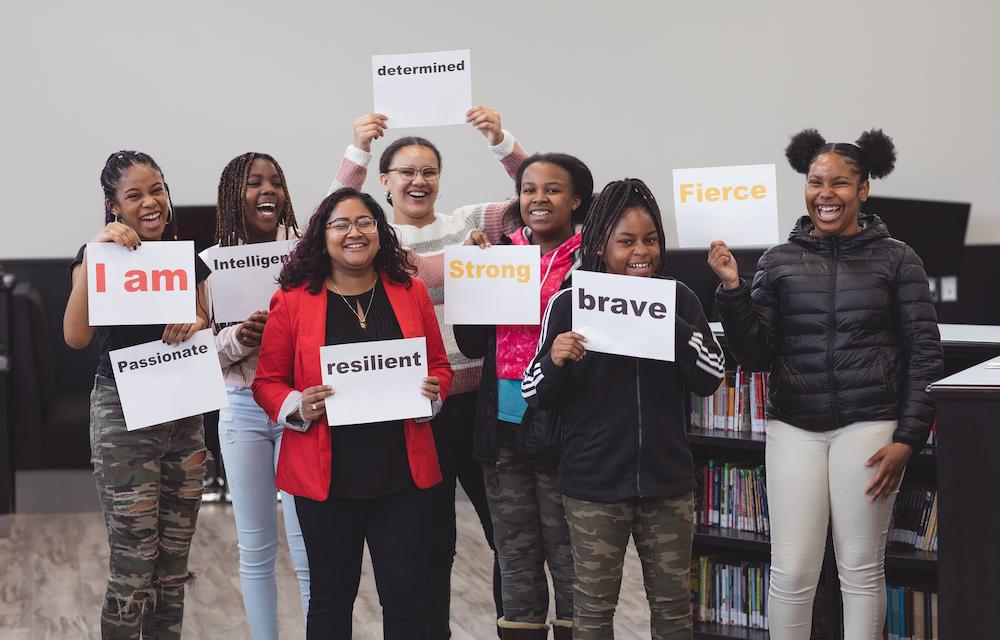
Inspiring Equity, Resilience and the Pursuit of Greatness in Female Students
Growing up, I always wondered why people told me that I was “too opinionated,” “too confident,” “too ambitious.” I never felt that I was “too” much of anything. I was just happy to be me. I often heard people refer to opinionated, confident and ambitious girls and women as “attention seekers,” but I never understood why. Why were boys and men who possessed these same qualities praised, supported and encouraged, when their female counterparts were told to “tone things down” or “stop trying to aim for more than they could achieve?” Year after year, my confidence diminished and I became quieter in settings with predominantly male audiences. Speaking up for myself started to feel foreign and out of place. I knew I had changed, but did not understand how or why it happened.
Fast forward to today. I find my female-identified students asking the same questions and sharing the same sentiments. They should feel supported in the development of who they are instead of constantly second guessing if they are behaving “appropriately” as girls when these questions are raised at home, at school or at work.
There is a staggering disparity between the number of men in management level positions versus the number of women – men 64.9 percent and women 35.1 percent. Statistics Canada reports that “61.4 percent of Canadian women participated in the labour force in November 2018, compared to 70 percent of men.” Only 10 percent fewer women are participating in the labour force than men. Why are so few women in positions of power and leadership? How is this possible in 2019?
As educators, we must understand the challenges our female-identified students face on a regular basis and the key elements that influence their perceptions of themselves and their abilities to be the leaders of tomorrow. We must ask ourselves why women are less likely to earn equal pay for work of equal value, why the media and popular culture continuously reinforce gender stereotypes and why so many girls back away from male-dominated careers. We live in a world of incredible opportunity, but I continue to ask why girls do not have the same access to support and encouragement as their male counterparts. We must work together to create these opportunities and to offer spaces for empowerment and critical reflection. Challenging societal pressures and naming systemic barriers need to be at the centre of how we educate and empower girls.
Pathway Planning
According to Statistics Canada, in 2016–2017, 56.1 percent of people enrolled in postsecondary programs were women, meaning women are actively seeking higher education opportunities. If this is the case, what supports are in place to equip them to face gender barriers in the workforce? Women have more than what it takes to be successful. How are we connecting, as educators, with our female students to ensure that they are making informed decisions about their futures?
Ways to support female students in Pathway Planning:
- Explore non-traditional female career options and reflect on the core skills and abilities needed to excel in those careers.
- Engage in the process of career/life planning so girls are able to develop and apply a deep understanding of the knowledge and skills needed to make informed choices about their futures.
- Explore the idea of listening to their inner voice so they are able to pinpoint the areas of strength and passion that make them WHO they are.
- Analyze the concept of WHO they want to be, instead of WHAT they want to be; career planning isn’t always easy so have girls think about the WHO; do they want to be someone who works with computers, someone who uses tactile learning skills, someone who leverages their passion for computer science. By identifying the WHO, they are better able to narrow down the WHAT for potential career paths.
- Discuss the barriers and concerns they feel may impact their life choices and work toward finding collective solutions.
How do I Get Started?
Analyze your mindset: Do you fully support the idea of girls having the potential to be anything they want? If not, why do you feel differently? Is it your lived experience? Is it what you have seen in the media or something you have been taught?
Do your research: Take the time to look at the statistics supporting female empowerment and the positive outcomes they create. Ensure you are exploring a variety of different sources and talk to girls about the barriers and obstacles they face.
Create spaces of understanding and nonjudgmental support: Ask yourself if a space exists in your school where girls can come together and discuss topics that are meaningful to them. Allow an open forum where girls can express themselves and feel supported. Co-create an outline space that allows tough subjects, such as gender microaggressions, their leadership identity and barriers they face in the advancement of their own learning, to be explored.
Select meaningful topics to explore: Ensure that time together is purposeful and directly addresses an area of focus for the group. Take a look at female leaders who have overcome a wide variety of barriers and analyze the strategies they used. Make sure your approach is intersectional and that you show women leaders whose identities are as diverse as their leadership positions.
Some Potential Areas of Focus
Self-expression: It is important that girls are able to find and develop their own voices. Creating spaces where girls know they are surrounded by the security to share their thoughts and points of view allows them to dig deeper into their ability to express themselves. Create a space where positive and healthy forms of self-expression are encouraged and respected. Encourage self-expression so girls learn to tap into their own creativity and find innovative ways to solve current and future problems. This will support and drive the initiative to take risks and build confidence in their abilities.
Entrepreneurship: Provide female students with the chance to see themselves as successful by looking at the skills they possess and teaching them how to leverage those skills. Introduce them to positive female role models from a variety of different pathways (careers; non-traditional female careers, skilled trades, STEM careers, and lifestyles; stay-at-home parent, shift worker, full-time worker, business owner, etc.). Create opportunities for them to develop their personality traits and transferable skills. Teach them that having a different point of view about a situation is not something to be scared of; in fact, it is a key strength they bring to the table as it facilitates discussion and promotes change.
If we can boost self-esteem and confidence, our female-identified students will be equipped to rise above gender-norms, cultural expectations and social constraints, empowering them to overcome the systematic barriers of both the education system and of society.
Well-being: Allow female students to have open and frank conversations about their own self-images. Do this by building a safe space where they can take risks and honour who they are. Be brave; discuss topics such as body image and how to develop a positive view of themselves. If you are unsure how to do this, contact outside agencies to come in and work with your students. Support a culture of success and high expectations, teaching girls they can achieve their goals and surpass expectations. Introduce them to the research behind the influence of social media and how it can both positively and negatively affect their personal development and wellbeing. Take a good hard look at the societal pressures they face and facilitate discussions around how they feel they have been impacted and what they want to do about it.
Allyship and Practical Tips for Supporting Female Students
- Host an open forum where girls can gather to discuss the obstacles they face at home, in school, in their community, in society. Make sure your approach is intersectional and considers the different aspects of their identities and how they impact individual experiences.
- Foster a community of self-confidence and support; create a mentorship program where female-identified students are able to connect with senior students and staff to discuss what is important to them. Bring in individuals or organizations to run workshops around self-esteem and personal development.
- Teach what it means to be a global citizen. Understanding the restrictions and conditions that other women live with on a daily basis in a global setting gives perspective and helps understanding.
- Introduce positive female role models from diverse backgrounds who have followed different career paths and lifestyles.
- Create an atmosphere where girls feel comfortable to be themselves, make mistakes, use constructive criticism and surpass expectations.
The purposeful creation of open, nonjudgmental spaces will allow our female-identified students to feel confident in themselves. Educators must remember that girls are full of untapped potential. They must receive the support and guidance they need to challenge systematic barriers and rise above their own expectations. Let’s change our dialogue; let’s change our world.
Allison Ebanks is a member of the Durham Teacher Local.
Resources
5 Reasons Why empowering Girls Matters
unfoundation.org/blog/post/5-reasons-why-empowering-girls-matters/
international Women’s Day: How to Empower Female Students in School
theguardian.com/teacher-network/teacher-blog/2014/mar/08/international-womensday-empower-female-students-education
Emma Watson at the HeForShe campaign 2014 - Official UN Video
youtu.be/gkjW9PZBRfk
Gender Equality: The Unfinished Business of Our Time
un.org/en/sections/issues-depth/gender-equality/
What is the HeForShe Movement? - Goal 5 - Achieve Gender Equality
hail.to/united-nations-association-unwebquests/publication/2PBYXiF/article/t6iw6yl
Why Women-only Programs Work
static1.squarespace.com/static/Why+Women+Only+Programs+Work.pdf
Why Gender Balance Matters and How to Achieve It, Luyten, Dirk.
alumnimagazine.insead.edu/why-gender-balance-matters-and-how-to-achieve-it/#

